
Please Note: This is a temporary mirror site for The American Top 40 Celebration Page, which seems to have vanished off the face of the earth. If the operator of that site sees this, please get in touch with me via the guestbook. Also please note some of the links are not operational at this time; they will be activated over the next few weeks.


Click HERE to hear the ORIGINAL AMERICAN TOP 40 Theme! (Now in glorious mp3 mono!)
Top 40 Rock Show Aims For 150 U.S. Cities
(Originally appeared in Billboard 11 July, 1970)
LOS ANGELES-"American Top 40," a network rock show,
has set a goal to hit
150
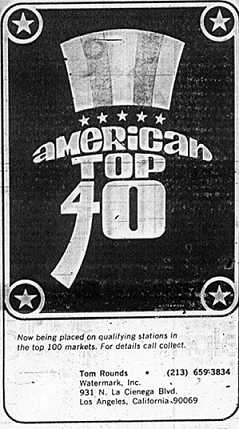 U.S.
cities plus an additional 20 stations overseas. The show, which uses the
Top 40 of each week's Billboard's Hot 100 chart, previewed last weekend July
3, 4, and 5, in 10 key U.S. markets and will be placed on qualifying stations
in 50 other markets Sept, 30.
U.S.
cities plus an additional 20 stations overseas. The show, which uses the
Top 40 of each week's Billboard's Hot 100 chart, previewed last weekend July
3, 4, and 5, in 10 key U.S. markets and will be placed on qualifying stations
in 50 other markets Sept, 30.
"American Top 40," which features veteran rock jockey Casey Kasem is based on a concept by Ron Jacobs, vice president of Watermark, Inc., Los Angeles-based firm. The program's executive producer and president of Watermark, Tom Rounds, has developed a production and distribution system that guarantees delivery of the program to stations in time for broadcast the weekend before print release of the "Hot 100" in Billboard.
Rounds is currently offering selected stations in markets throughout the U.S. exclusive contracts to broadcast "American Top 40" in their market. Interested stations contact him at Watermark.
According to Art Astor, Watermark's director
of sales, stations are finding they can actually upgrade a neglected weekend time slot by offering fixed position
avails in a program that's getting special attention from the audience. For
example, KDEO in San Francisco (carrying "American Top 40" Friday evening
from 7 until 10) has landed a firm 52-week buy of participating spots in
"American Top 40" at a premium rate.
The 10 markets in which the show kicked off were Boston, Philadelphia,
Detroit, St. Louis, San Antonio, San Diego, Minnesota, San Bernadino (Calif.),
Albany (N.Y.) and Honolulu.
Click here to see the very first American
Top 40 countdown chart!
With that small article began the institution that is "American Top 40."
As much a part of the 70s, 80s and 90s as any television program, many people grew up listening to at least part of a show once in their lives. If you listened to a pop station on the radio on the weekends, chances are you caught American Top 40, even if you didn't know it.
It's hard to believe, with countdown shows so common today, that the concept of a national radio based countdown show didn't materialize until 1970. To be sure, there were variants of the format in the past. "Your Hit Parade" was around as early as the 1930s, but it wasn't a countdown show as we know it, and its methods of proclaiming the top songs in the country were dubious at best. Local stations in the 50s and 60s would occasionally put together countdown shows of their own consisting of their playlists. But it wasn't until 1970 that the idea of a nationally syndicated countdown show got off
the ground and became a reality.
The early shows had a very fast-paced feel to them. Long stories leading up to a particular song were completely absent and the turnover from one song to the next minimal. Almost immediately the show began to modify itself by allowing Casey to bring up interesting, if not always useful, facts about the song. Casey had built up for himself a reputation for song and chart trivia long before the start of AT40. This was a major factor in the early
success in AT40, was Casey's ability from turning the show into another "countdown of hits" program. The facts sometimes stretched beyond simple trivia about music. A song about kissing might lead Casey to devote part of the program to the history of kissing for example. It was in this way, in part, that Casey would soon became the most important part of AT40 in the minds of many fans.
Above is a copy of a letter sent out by Tom Rounds. Occassionally Tom would send out memos like this to subscribing stations informing them of changes.
"The American Top 40 Double Dozen"
In the Summer of 1971, American Top 40 offered a two record set of 24 songs called "American Top 40 Double Dozen of Hits, Vol. 1" (Custom Fidelity CFS-2315-2). Ads for the album ran in between the countdown but not during the normal commercial breaks. Casey did not promote the album himself, but instead an anonymous announcer did so. The album was strictly a mail order deal and today has gotten to be very rare and quite valuable. The album was only $4.99 when offered on American Top 40.
Casey, contrary to earlier reports, does NOT appear on the album, but he did write introductions to each song in the liner notes, giving a bit of history on it. (And in case you were wondering, the label was the standard Custom Fidelity rainbow-and-black label, with no mention at all of American Top 40 on it.) Key to the success of AMERICAN TOP 40 rests with the talents and energy of one man...Casey Kasem. Casey would be first to credit the WATERMARK team of 22 who help produce and distribute the taped show. He would also credit his producer/writer, Don Bustany, and Billboard Magazine, the nation's leading music magazine which furnishes weekly chart information.
But it's Casey who makes it all happen. He brings to the program his many years of experience as a top-rated disc jockey, his intimate knowledge of popular songs and stars, and, of course, his great voice which you've heard on hundreds of television commercials and cartoon shows.
But Casey adds something even more important...his genuine love for the exciting and ever-changing music of America, and the world. He truly enjoys bringing you AMERICAN TOP 40 each week. And it shows.
In the limited space here, Casey has provided us with some insight and history of 24 popular records and artists that make up this first AMERICAN TOP 40 Album of Hits! Side 2: Side 3: Side 4:
3 Hours and 4 Hours
However, as the 70s progressed the 3 minute barrier began to be broken more and more often and the average length of songs on the Top 40 began to slowly climb. Many reasons for longer songs can be cited. The Beatles "Hey Jude" is commonly cited as the record that made it possible for others. But here are some other reasons: FM radio influence, which played longer album cuts, and the arrival of Disco, in which songs commonly clocked in at 4 minutes or longer.
By 1978, AT40 was forced to seriously edit 4 or 5 songs per countdown (at the very least) in order to "make room" for all 40 songs in the 3 hours. Clearly a longer countdown was needed. Therefore, during the weekend of October 7, 1978 AT40 expanded to 4 hours. The additional hour not only allowed for playing all 40 songs in full, but also made room for additional Top 40 features, the most famous being the "Long Distance Dedication". Odd to think that LDD's didn't even exist until the the show was in its 8th year.
"Casey Kasem's American Top 40 Yearbook"
An interesting sidenote in the history of American Top 40 was the publication of the "Casey Kasem's American Top 40 Yearbook" for 1978 in early 1979. Published by Grosset and Dunlap, this book was AT40's journey into the world of music and chart books. Inside were biographies of all the acts who had a top 40 hit in 1978 as well as something about the song(s) they charted with. In the back of the book were complete reproductions of all the top 40 charts
for 1978, a listing of the top 40 biggest hits on all of Billboard's major record charts for 1978, and perhaps most interestingly, some commentary on the year in charts:
"The Pop Scene, 1978" was written by Greg Shaw who compares 1978 to 1962, in which the top 40 was okay but uninspiring. He remarks that there were several good singles in the "bottom 60" and expresses hope these acts could get into the top 40 for 1979.
"The Soul Scene, 1978" was written by Leonard Pitts, Jr. On commenting on the R&B charts, he remarks at the rise of funk on the charts with many acts trying their hand at funk, some successfully but many not. Non-funk acts, Pitts remarks, had a less than steller chart performance on the R&B charts as a result. Disco's influence on the R&B chart was inescapable, not a totally bad thing, but he hopes for more inspired R&B records in
1979.
"What's County" by Pat Shields (head writer for AT40's sister show, AMERICAN COUNTRY COUNTDOWN) talks about Country's success on the pop charts in 1978. Although disco was everywhere, Country songs made unheard of gains on the pop charts that year, leading many Country purist to question whether Country music as a form was "watering down" to make it more appealing to pop audiences. Shields suggests that the Country music of 1978 is not the Country music of the 1920s, and that like all forms of music, Country changes with the times, but will always be Country.
"The Disco Scene, 1978" by Bill Wardlow talks about disco's explosion onto the pop charts in the last few years leading to its best year yet in 1978. He talks about how disco clubs influence in breaking many new acts in the last few years, and of course, the movie "Saturday Night Fever". However, Wardlow is a bit too optimistic about disco's fortunes in 1979.
This was the only year AT40 did something like this, which is a shame. In 1979, AT40 gave away several copies of the Yearbook as prizes. It's long out of print, but can still be found in used book stores. Get it if you ever see a copy, it's a great and informative book.
American Top 40 and its competitors
(special thanks to Emi Briet for help in this section)
One question I get asked were shows that were made to be in direct competition to American Top 40. After AT40's success, it wasn't long before other networks tried to imitate the successful formula of American Top 40 into their own program. During most of the 70s, competition was neglibable. Except for the Opus year-end countdowns that were competing against AT40's year-end countdowns, there were nothing to dent AT40's hold on this format.
The first show to make its appearance to directly compete against AT40 nationally was Drake-Chenault's "The Weekly Top 30" which was hosted by former frequent AT40 guest host Mark Elliott. It began in 1979 and based its rankings from its own sampling rather than from a magazine (like Billboard or Cashbox). Geared
slightly towards adult leaning stations, the countdown usually included songs popular on both pop and Adult Contemporary radio stations. The show was successful enough to attract a decent number of stations. The program ended in 1982. Although just speculation (can anyone confirm?) I believe the show went into a major reorganization that year and came back as the very successful
Rick Dees' Weekly Top 40.
The next popular countdown show to make its appearance was "Dick Clark's National Music Survey" which began in 1980 and lasted until 1986. This show was definately aimed towards Adult Contemporary stations although many pop stations also aired it. It was Top 30 chart.
In 1983, as mentioned earlier, "Rick Dees' Weekly Top 40" appeared. At first the show based its countdown on the charts from Cashbox magazine (since the 1940s Billboard's main competitor in record charts) but later switched over to Radio and Records chart. Certainly the most successful of all the AT40 imitators, the show has now been on for 17 years, won many awards, and shows no signs of ending.
In the mid-80s, yet another countdown show appeared, "Countdown America", a top 40 chart hosted by John Leader. In 1986 he was replaced by Dick Clark (who's NMS had ended), but it died soon after. Leader himself began his own countdown "Countdown USA" but it barely lasted a year.
That Year 1988
Back in February 1988, a front page story appeared in Billboard stating that the only host AT40 ever had may "exit". This was the first time anywhere that news appeared that all was not well with the American Top 40 show. Casey was in his final year of his contract with ABC, which acquired Watermark in 1982. And things weren't looking good. At the time, Casey was the highest paid radio personality in American with an annual salary of $1 million according
to Billboard. Beginning as early as 1986, Casey and ABC were conducting talks for a new contract - either a renewal of his 7 year one, or a shorter 5 year one. At the time nothing was more popular on radio than AT40. 475 stations were carrying the show in the US alone, not to mention about 500 overseas stations. It was currently ranked 6th in syndicated programs at 2,399,000 listeners but first in entertainment radio programs. But talks began to stall.
The article that appeared was not firm on the facts of why. But it was rumored that the up-and-coming Westwood One was trying to lure Casey away with a $3.2 million per year contract. Westwood One denied this. As a result on February 9th, ABC announced is was seeking someone to replace Casey. It did state that Casey might continue on regardless, but that it was not likely. Neverthless, ABC went out of its way to state that the upcoming parting was amicable and that the writing and production staff of the show would remain unchanged.
The next news came in the first week on April, 1988 and was reported in both Broadcasting and Billboard magazines. It was an official announcement that Casey was indeed leaving ABC at the end of the year for Westwood One. So the rumors reported back in February seemed to be true. The contract would be for $13-$14 million over a five year period beginning in January 1989. The show would be similar to the American Top 40 format with "Casey" in the title as well at "Top 40". Westwood One was not alone in seeking Casey, 5
other networks were as well. Casey commented that Westwood One's aggressive stance was the primary motivation for moving there. ABC announced that over 600 people had so far applied for the now vacant AT40 host job and an announcement on who the new host would be coming in May. Broacasting speculated the top names applying were John Tesh and Shadoe Stevens. The current question was whether Casey would remain as AT40 host until December or the replacement would have taken over by then.
Come the 29th of May issue of Billboard, a page one article announced Shadoe Stevens was chosen to take over as host for AT40. No firm date for the transfer was set except for the period of mid-July to early August. ABC did announce that Casey would be around for the upcoming 18th Anniversary special on July 4th "The Triathalon of Rock and Roll". But it appeared that Casey would not be on air to finish out his contract which ended in December. Radio stations were cautiously optimistic about Shadoe's arrival. Most expressed confidence that the show's longevity and writing would be enough to make any problems of Shadoe's taking over minimal.
Shadoe stressed that the show's key features and formats would remain unchanged. ABC said that no on-show announcments of Casey's departure or Shadoe's arrival would happen, but a massive ad and marketing blitz would nevertheless take place. That very issue contained a three page ad of Shadoe's arrival. The last week of July saw the last program with Casey Kasem who left the show with no fanfare. The first week of August shaw the arrival of Shadoe, with a long introduction of the show's history.
Meanwhile, Westwood One was busy promoting its new show now officially called "Casey's Top 40" set to began the first week of January 1989. An article appeared stating that many markets were going to carry both this show and "American Top 40," although some stations without AT40 were opting for "Casey's Top 40." So the beginning of 1989 saw the beginning of a third major Top 40 nationally based countdown.
The Final Years 1989-1995
Starting in 1989, it seemed Top 40 (CHR) radio could do no wrong. The format was the 3rd largest in number of listeners in the US according to Arbitron (AC and News/Talk were ahead), and was fourth in number of stations (AC, News/Talk and Country had more) The format also had over 50% of all listeners ages 12-17. Each of the countdown shows had well over 300 subscribing stations in the US. But then something happened. Although it can be debated how and why it happened, the fact is is that Top 40 radio began to fall - and rather
dramatically. The first reason seemed to be the dramatic growth of the Country format. The second seemed to be the fact that "pop" radio was begining to have an identity crisis. Many Top 40 listeners didn't like many of the "hard rock/rap" songs that were popular, while others liked those, but disliked the AC oriented songs. As a result of this and audiences seeming to switch to a format of their tastes. The number of Top 40 stations in the US began to decline.
The first effect of all this in regards to the 3 main countdowns was AT40's decision in November 1991 to switch its countdown from being based on the Hot 100 chart to the airplay part of the Hot 100. This was in response to radio stations who didn't like many of the hard rap songs that charted on the Hot 100 due to sales. The decision was not greeted with enthusiasm by many AT40 listeners. A few letters appeared in Billboard expressing this.
"Casey's Top 40" and "Rick Dees' Weekly Top 40" both used the CHR chart from Radio and Records magazine, which was already an airplay only chart.
Billboard in their 11 April, 1992 issue ran an article talking about the trials the 3 countdowns were facing due to an increasingly smaller market of stations to pool from.
375
Added to this was a glut of up and coming new countdown shows both on the national and local level. Gone were the days where a local countdown show was a "poor imitation AT40" show. These local shows could be as slick productionwise as the national ones.
The article suggested that survival of any of these big 3 countdowns was in question. Casey seemed to be the most secure, since the show was increasing affiliates and it had veteran Casey Kasem. Added to this was the fact the WW1 was introducing "Casey's Countdown" to market to Top 40 Adult and AC stations. So the battle was between AT40 and Rick Dees. Both shows were going for the younger demographics.
Radio stations were split about the end result of all this would be, but all seemed to figure that one of the big 3 was going to have to go soon. All ventured guesses on which it would be and gave their reasons.
Shadoe Stevens wrote a letter to Billboard in response to the article in the 25 April 1992 issue. Shadoe criticized the article for neglecting to mention the overseas influences. True, AT40 now was 3rd in the number of US affiliates, it still was the leader in overseas listeners. Shadoe mentioned that the show was very healthy.
Rick Dees celebrated his 10th anniversary in 1993, the show seemed to be more popular than ever. Meanwhile WW1 was forced to redesign the "Casey's Countdown" show and split it into two shows. The first would still be called "Casey's Countdown", a Top 20 countdown marketed to AC stations, while the second show would be called "Casey's Hot 20", given to Hot AC and Adult Top
40 stations. AC stations complained that the old program, which was based on Radio and Records Hot AC chart was too hard for their stations.
The nail in the coffin for AT40 came from ABC Networks itself. ABC in 1994 acquired Rick Dees' Weekly Top 40 and decided it was the better of the two countdowns. Therefore in July 1994, when ABC took over Dees', it would stop AT40 for US distribution. ABC did state that the show would still continue to the overseas stations, which at the time represented well over half of AT40's listeners.
AT40 continued on until the end of Janurary 1995 where it ceased for good.
But the story doesn't end there.
The Show Comes Back
In 1995 AT40 was gone but Casey Kasem was around more than ever. His "Casey's Top 40" show was one of the few bright spots in the doldrums of CHR radio at the time. The show was able to survive by a combination of Casey's personality and charm and the show's solid format. Nevertheless it was hard times as many major markets didn't even have a Top 40 station, and those that did didn't play many of the songs on Casey's show. Tight playlists with long chart rides were the rule. It was the era of the 40 week chart run for many
singles in the countdown - something unimaginable in the 70s and 80s.
Nevertheless by 1997-98, Top 40 was beginning to turn around thanks to a number of new hot acts.
ABC still owned the rights to "American Top 40," including the name and jingles even though they no longer produced the show. However by 1998, their rights expired and they reverted back to the shows'
creators: Casey Kasem and Don Bustany. Casey now had the rights to his show back and he wanted Westwood One to change the name of "Casey's Top 40" to "American Top 40." However Westwood
One declined.
Instead AMFM Networks came along and expressed interest in reviving AT40. Casey agreed and sold his rights to AMFM (Don Bustany had given his rights to Casey). So AMFM were committed to restart "American Top 40" in March 1998. To celebrate they re-issued the first AT40 show of July 1970 on CD as a promotion. So in March 1998 Casey left "Casey's Top 40" to begin again his role as host of AMERICAN TOP 40! Many radio stations simply substituted
shows as Westwood One decided to scrap the Top 40 show all together rather than finding a new host, although during its final week the show was called simply "The Top 40" and a substitute host did the countdown.
Today "American Top 40" is now celebrating its 32nd year and as long as Casey is committed to doing the show it looks like AT40 has a bright future.
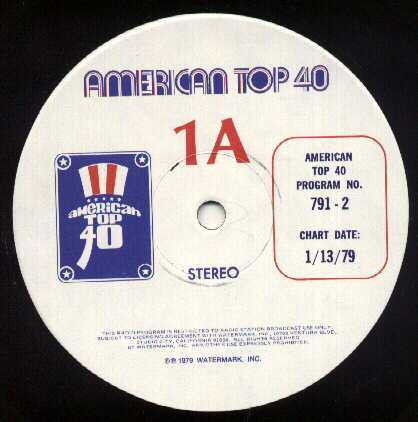
Despite what the article above says, that first AT40 show only aired in seven markets: Boston, St. Louis, San Antonio, Lubbock, San Bernardino, San Diego and Hollywood. After that start, the stations slowly increased. AT40 was one show that was offered as an exclusive to its market. If one station in a particular market offered to pick it up, then they would be the only station in the listening area allowed to air AT40. This was an attempt to make the show more attractive and it worked. By 1975, over 300 markets in the US were airing the show. Originally the show was aimed solely to the
top 100 markets, but soon it became apparent that it was the small and mid-level markets that were AT40's base.
The basis for what would become American Top 40 had its start in 1969. Ron Jacobs had recently had a successful syndicated show called "History Of Rock And Roll". Jacobs and Tom Rounds formed Watermark. Around the same time Casey Kasem and Don Bustany formed K-B Productions who sought to get the idea of a national countdown show on the air.
1970 was something of a watershed year at radio. FM stations were popping up across the country and the shift in tastes were leaning towards a heavier sound and album cuts. Lite pop music was thought to be the stuff of the 60s, singles, AM radio and countdowns. Therefore, Watermark faced a tough sell to radio stations. Nevertheless, many stations were attracted to the idea of a 3 hour syndicated show that they could put in an otherwise slow time
slot.

The outside of the AT40 Double Dozen
The inside gatefold.
Click on the images to see larger versions. Printed below are the liner notes as they appear in the gatefold.
1. VENUS by The Shocking Blue...The first recording act from Holland ever to have a song hit #1 on the American charts. VENUS did it in February, 1969.
2. TRACES by The Classics IV, featuring Dennis Yost...Five musicians from Florida and Alabama. Besides Dennis, there's lead guitarist Jim Cobb, rhythm guitarist Wally Eaton, drummer Kim Venable, and bass guitarist/vocalist Joe Wilson. TRACES hit #2 in March, 1969.
3. SUMMERTIME by Billy Stewart...A hit from Gershwin's American opera, "Porgy and Bess," by the late rock stylist. It hit #10 in the summertime of 1966.
4. SUGAR ON SUNDAY by The Clique...This hit #22 in September of 1969, and the group has had only one chart record since - a minor hit two months later called I'LL HOLD OUT MY HAND.
5. I'M YOUR PUPPET by James and Bobby Purify...A couple of cousins whose real names are James Lee Purify and robert Lee Dickey. Both were born in Florida. I'M YOUR PUPPET was the first of eight chart songs they've had, and it hit #6 in 1966.
6. EVE OF DESTRUCTION by Barry McGuire...1965 was the year that Watts went up in flames; it was the year that the United States really started getting militarily involved in Indochina; and it was the year that the first big protest song hit the #1 position on the record charts. This was it.
1. IN THE SUMMERTIME by Mungo Jerry...The English group that took its name from a cat in a book of poems by the late T. S. Eliot. They were on the verge of disbanding in early 1970 because it didn't look as if they were going to make it. Then, all of a sudden, IN THE SUMMERTIME caught on and hit #1 on many record charts all over the world, peaking at #3 in the U.S.
2. LITTLE BIT O' SOUL by The Music Explosion...Here's another example of a big hit by one of many recording acts that had a huge first-hit record, and then practically disappeared from the recording scene. This song was #2 in 1967.
3. WORKING IN THE COAL MINE by Lee Dorsey...A prize-fighter-turned-recording-artist, Lee was born in Portland, Oregon, developed into a top contender for the World Lightweight Crown, served his four years in the Navy, then continued his boxing career. But he got side-tracked. Record producer Marshall Sehorn heard him sing and then turned out a string of hits with Lee starting with YA YA which hit #7 in 1961. COAL MINE reached #8 in 1966.
4. YOU SHOWED ME by The Turtles...The now-disbanded group that rose to fame on a Bob Dylan tune, IT AIN'T ME, BABE, in 1965. Their biggest single, HAPPY TOGETHER, came in 1967, peaking at #1. YOU SHOWED ME reached #8 in 1966.
5. COWBOYS TO GIRLS by The Intruders...A four-man vocal group comprised of Sam (Little Sonny) Brow, Robert (Big Sonny) Edwards, Eugene (Bird) Daughtry, and Phillip Terry...all from Philadelphia. This single and an album of the same name hit the chats in 1968, the single going to #6.
6. ELUSIVE BUTTERFLY by Bob Lind...The singer who, in his early teens, managed to struggle through four guitar lessons before his teacher quit. His smash version of ELUSIVE BUTTERFLY went to #5 in 1966.
1. THIS MAGIC MOMENT by Jay & The Americans...A five-man group that's had huge hits throughout the Sixties: SHE CRIED in '62, COME A LITTLE BIT CLOSER in '64, CARA MIA in '65, and THIS MAGIC MOMENT in '69. It hit #6.
2. AUTUMN OF MY LIFE by Bobby Goldsboro...The avid baseball fan who had a special clause written into his recording contract stating that he never had to record while the World Series is being played. This tune of his reached #19 in 1968.
3. HAPPY by the Sunshine Company...Four guys and a pretty girl who got together in the summer of 1967, the year of this hit. There's Maury Manseau, Doug Mark, Merel Breganta, Larry Sims, and Mary Nance.
They've said they like to make their music sound like their name.
4. HOLD ME, THRILL ME, KISS ME by Mel Carter...The singing sensation from Cincinnati who worked his first big professional engagement with Lionel Hampton...when he was only nine years old. It was 1965
when this smash single of his hit the charts, peaking at #8.
5. NO MATTER WHAT SHAPE (Your Stomach's In) by The T-Bones...This was the music from the Alka-Seltzer TV commercial that hit #3 in 1965 in this pop version by these five musicians.
6. SEALED WITH A KISS by Gary Lewis & The Playboys...The group that racked up seven consecutive Top Ten hits from February '65 to June '66. And they did it without the help of Gary's famous father, comedian Jerry Lewis.
1. GOING UP THE COUNTRY by Canned Heat...The group whose 280-pound lead singer is out-weighed by his record collection. He owns 40,000 discs. One of them, GOING UP THE COUNTRY, hit #11 in 1968.
2. COME BACK WHEN YOU GROW UP by Bobby Vee & The Strangers...This is the shy, softspoken kid from Fargo, North Dakota, that everybody likes. And Bob Dylan was once a member of his group. In 1967, this million-seller hit #3 on the charts.
3. BUY FOR ME THE RAIN by The Nitty Gritty Dirt Band...The six-man group that's easier to recognize by their appearance than by their sound. They walked into a second-hand clothing store with ten dollars, and walked out with six outfits dating back to the 1920's.
Their clothes match the funky sound they make with such instruments as kazoo, washboard, and comb.
4. A HUNDRED POUNDS OF CLAY by Gene McDaniels...Born in Kansas City, raised in Omaha, he formed his own vocal group when he was eleven years old - a group that lasted nine years! But it was as a solo artist that Gene made it into the bigtime. CLAY hit #3 in 1961.
5. GOIN' OUT OF MY HEAD by Little Anthony & The Imperials...The vocal quartet from Brooklyn. They were the first of the rock groups that were big in the Fifties to hit it big again in the Sixties. This tune was a smash in 1964, peaking at #6.
6. NEEDLES AND PINS by Jackie De Shannon...The first female vocalist signed by the Beatles to perform with them on tour in this country. She's also a songwriter and an actress. Her string of hits includes YOU WON'T FORGET ME, WHAT THE WORLD NEEDS NOW, and PUT A LITTLE LOVE IN YOUR HEART.
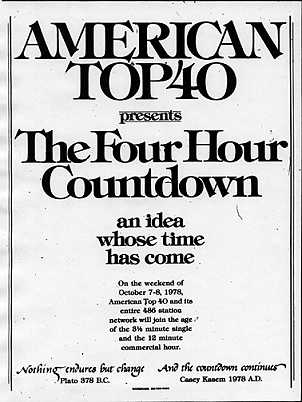 American Top 40 was a 3 hour program when it first began. When the show began in 1970 songs averaged about 3 minutes or less. Sure, there were longer songs, but they were the exception rather than the rule. In fact, in the 1960s many AM stations had a "3 minute" rule, in which they would not play any song over that or if they did, they edited it.
American Top 40 was a 3 hour program when it first began. When the show began in 1970 songs averaged about 3 minutes or less. Sure, there were longer songs, but they were the exception rather than the rule. In fact, in the 1960s many AM stations had a "3 minute" rule, in which they would not play any song over that or if they did, they edited it.
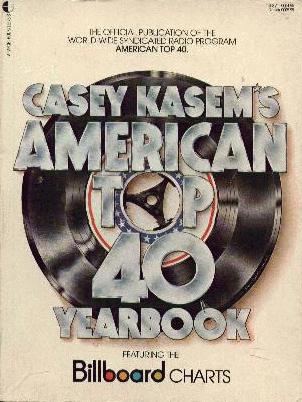
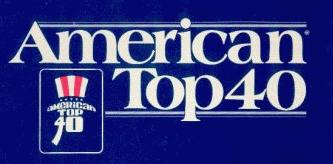
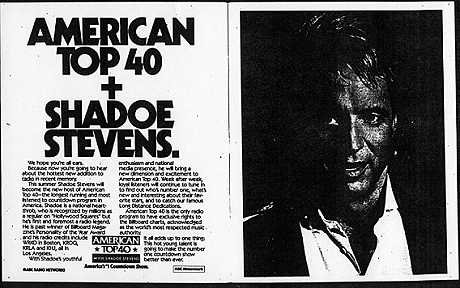
Program
US Stations in 1991
US Stations in 1992
American Top 40
265
Casey's Top 40
320
400
Rick Dees' Weekly Top 40
320
350

UPDATE: Since 2002, when this was written, AMFM was taken over by the Premiere Radio Networks; Ryan Seacrest succeeded Casey as AT40 host in January 2004. Casey continues to host the two syndicated spin-offs, American Top 20 and American Top 10. In 2007, Premiere began re-syndicating the original AT40 shows as "Casey Kasem's American Top 40: The 70s" and "...The 80s". These programs are digitally remastered by Shannon Lynn of Charis Music Group (although, to the consternation of some AT40 purists, Premiere seems to see fit to substitute stereo songs in place of the original 1970-73 mono tracks, thus mucking up Shannon's hard work. Also, to make room for more commercials, some features are edited out. This has led to, on at least one occasion, Casey "teasing" a story about The Band, but the story itself was never played!) And thanks to the internet, listeners in areas that don't carry either classic version can hear them streamed on stations that choose to do so. And for a few years now, those classic shows can be heard in unedited form on XM satellite radio.
In the immortal words of Casey..." and the coundown rolls on!"
Main Page
History
Special Countdowns
Yearend Countdowns
Jingles
AT40 Book Of Records
Links